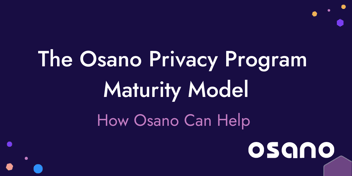
How Osano Can Help
How Osano Can Help You Mature Your Privacy Program Building, running,...
Read NowGet an overview of the simple, all-in-one data privacy platform
Manage consent for data privacy laws in 50+ countries
Streamline and automate the DSAR workflow
Efficiently manage assessment workflows using custom or pre-built templates
Streamline consent, utilize non-cookie data, and enhance customer trust
Automate and visualize data store discovery and classification
Ensure your customers’ data is in good hands
Key Features & Integrations
Discover how Osano supports CPRA compliance
Learn about the CCPA and how Osano can help
Achieve compliance with one of the world’s most comprehensive data privacy laws
Key resources on all things data privacy
Expert insights on all things privacy
Key resources to further your data privacy education
Meet some of the 5,000+ leaders using Osano to transform their privacy programs
A guide to data privacy in the U.S.
What's the latest from Osano?
Data privacy is complex but you're not alone
Join our weekly newsletter with over 35,000 subscribers
Global experts share insights and compelling personal stories about the critical importance of data privacy
Osano CEO, Arlo Gilbert, covers the history of data privacy and how companies can start a privacy program
Upcoming webinars and in-person events designed for privacy professionals
The Osano story
Become an Osanian and help us build the future of privacy!
We’re eager to hear from you
Benchmark and Grow Your Organization’s Privacy Program
Your privacy program should provide notice to data subjects regarding a spectrum of information on your data processing activities, including the purpose for collection, data subjects’ rights, how the data will be retained and disposed of, to whom the data will be transferred and how, what security measures have been deployed, and more.
An immature notice and disclosure management process may have some or all of the following characteristics:
As a result, individuals won’t understand what your organization is doing with their data, what rights they have in regard to that data, and whether or not your organization can be trusted with their personal information. Not only does this damage your relationship with groups like potential stakeholders, but it also puts you at risk of violating data privacy regulations.
In contrast, a mature notice and disclosure management process involves:
To increase the maturity of your privacy notice and disclosure management process, you can take the following actions:
With Osano, building, managing, and scaling your privacy program becomes simple. Schedule a demo or try a free 30-day trial today.